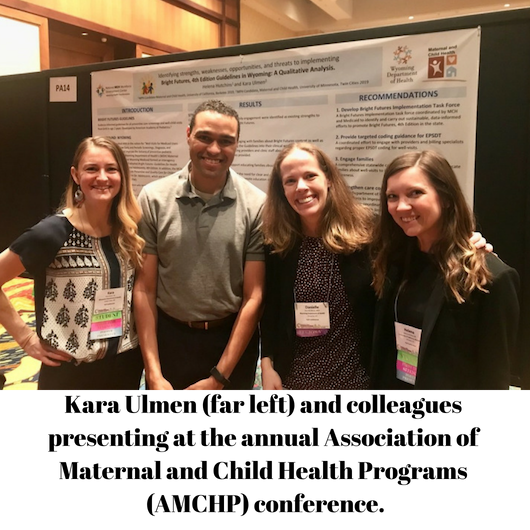#UMNMCH student Kara Ulmen (MPH 2019) wrote this reflection on her applied learning experience at the Wyoming Department of Health’s Maternal and Child Health Unit as part of the Maternal and Child Health Workforce Development (MCHWD) Title V Internship Program.

When I completed my Bachelor of Arts in Global Studies, I was focused on the social, economic, and political factors affecting the way people live in developing countries. When I decided to go back for my masters, I applied because I became passionate about maternal and infant health disparities as well as global female rights to education and reproductive health justice. Focusing on rural health in the United States was not my target so when I was accepted to work with the Wyoming Department of Health’s Maternal and Child Health (MCH) Unit as part of the MCHWD Title V Internship Program, I felt out of my element and immediately began digging into the research in order to familiarize myself.
I found that Wyoming has had a history of falling behind National Performance Measure (NPM) targets. In 2015, among Medicaid recipients 18 years and younger, Wyoming ranked 44th in the nation. In 2016, 19.4 of children did not have a preventive care visit in the past 12 months (Medicaid.gov). As one Wyomingian put it, “The things that people of Wyoming are proud of [the ‘pull yourself up by your boot straps’ and ‘fight through the pain’ mentality] are the same things that have led to poorer health outcomes.” But as many of us have learned, the factors that play into people’s choices can be complex and often times go beyond the individual.
To address the low rates of preventative care visits, Wyoming Medicaid and the MCH Unit formed a partnership to better serve the same populations. Wyoming Medicaid adopted the Bright Futures: Guidelines for Health Supervision of Infants, Children, and Adolescents. This adoption meant that for providers who want to accept Medicaid reimbursement, they need to use the Bright Futures codes, which will accurately capture Early and Periodic Screening, Diagnosis, and Treatment (EPSDT) services. There is then an incentive to follow the recommendations in order to get the highest reimbursement for each well-child visit. The MCH Unit elected two priorities during their recent 5-year needs assessment that addressed child and adolescent health: 1) Promote Preventive and Quality Care for Children and 2) Promote Preventive and Quality Care for Adolescents. These two priorities aimed to improve four NPMs: #6: Increase the number of children who receive a developmental screening, #10: Increase adolescent well-visits, #11: Increase the number of children and adolescents using a medical home, and #12: Adolescents with and without special health care needs who received services to make transitions to adult health care.
With a co-intern, Helena Hutchins, MCH graduate student at the University of California at Berkeley, we conducted stakeholder meetings and a thematic analysis in order to develop recommendations on how to best disseminate and educate stakeholders on Bright Futures content. Through these meetings, the complexity of common barriers became clearer; not all healthcare providers code in a manner that captures EPSDT visits, it is not uncommon for families to travel 1+ hours to see their family doctor, healthcare providers struggle to find ways to incorporate Bright Futures recommendations into their workflow, often times families misunderstand the difference between a well-child visit and a sports physical, and behavioral screenings are happening more than we think but are not getting reported.

Through the Social-Ecological Model, I’ve learned that successful interventions are ones that intervene on more than one level. Better understanding the barriers that were discussed in our meetings, it was becoming clear that to increase preventive services rates, intervention would need to be multifaceted. Based off our research, 26 interviews, and three surveys, we created these four key recommendations that aim to address barriers and leverage existing resources:
1. Develop a Bright Futures Implementation Task Force
2. Provided targeted coding guidance to healthcare professionals for EPSDT
3. Engage families through statewide campaign
4. Strengthen care coordination and improve access to care.
Helena and I had the opportunity to present our field experience at the annual Association of Maternal and Child Health Programs (AMCHP) conference in San Antonio, Texas. We spoke with individuals from other states that are also using Bright Futures to address lower NPMs and learned that many face similar challenges. While the field of public health can sometimes feel like an uphill battle, I can say with confidence that it’s full of dedicated, intelligent, and persistent professionals that won’t stop their work so long as there is progress to be made. A quote that will continuously resonant with me comes from Charles Johnson, founder of 4kira4moms, “If we’re not investing in the health of our mothers, children and families, then what are we doing here?”
Source:
Medicaid.gov. Early and Periodic Screening, Diagnostic, and Treatment. Retrieved from https://www.medicaid.gov/medicaid/benefits/epsdt/index.html on June 25, 2018.
Kara is in her final year of the Masters in Public Health MCH Program with a Program Evaluation minor at the University of Minnesota, Twin Cities. She received her Bachelor of Arts in Global Studies with a Mass Communication minor from the University of Minnesota, Twin Cities. Her background is in adolescent health counseling, health communication, and organizational wellness programs. Kara currently works in the Family Home Visiting section as the Evaluation Unit’s Student Worker with the Minnesota Department of Health as well as the Education and Outreach intern with Planned Parenthood of North Central States. After graduating, Kara hopes to establish a career evaluating programs that aim to improve the health and well-being of communities or those that promote comprehensive sexual and reproductive health for all, domestically and globally.
Read Student Spotlight Archives
Interested in learning more about getting a degree in Maternal and Child Health? Visit our MCH Program page for more information.
#UMNMCH #UMNproud #UMNdriven